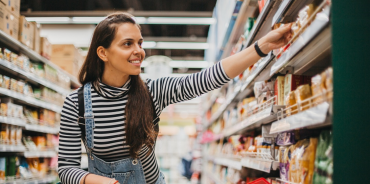Inflationary pricing and our latest Consumer Pulse findings
While issues like high in fat, sugar, and salt (HFSS) rules and supply chain disruption have taken their fair share of headlines in recent weeks, one issue above all else is coming to define the UK grocery industry in 2022: inflation.
The rising cost of goods has an impact on shoppers, retailers, and brands alike, and has become a dominant theme during the first half of the year. Three in five grocery retail CEOs believe that inflation will be the biggest factor to shape the industry over the next few years[1], and from a CPG perspective, recent studies suggest that loyalty towards national brands could already be waning in favour of private label goods[2].
Naturally, this presents CPGs with a significant challenge, and one that requires careful decision making to navigate effectively. And as with so many other trends within grocery, one of the best places to start is by establishing an understanding of how shoppers are reacting to the changes they see.
Established in March 2020, the Consumer Pulse is an ongoing dunnhumby research programme that covers 24 markets across four continents. Initially conceived as a way to keep track of changing shopper attitudes and behaviours during the early months of the pandemic, the Pulse has steadily grown to take a range of other macroeconomic factors into account – inflation being one of them.
In the results of the eighth and latest “wave” of the Pulse (conducted in February 2022), we can see the clear impact that inflation is now starting to have on the consumer mindset; 60% of respondents say they feel that their money doesn’t go as far as it used to when shopping. To put that in context, that’s a demonstrable increase from the preceding study (37%, September 2021).
Something else that quickly becomes clear is that perceptions about rising prices differ from country to country – as does the reality. While the rate of inflation is particularly high in countries such as Brazil (8% at the time of the survey) and Colombia (19%), shoppers in those locations also tend to believe that the cost of goods has risen much more than it really has.
In the UK, the consumer outlook seems to be a little more in line with actual changes in pricing – for now, at least. While perception still outstrips reality, the gap between the two is far smaller amongst British shoppers. Nonetheless, many are still taking action as they seek to protect themselves from the impact of inflation.
In a separate piece of research conducted through dunnhumby’s Shopper Thoughts panel in March, we looked explicitly at customer behaviours in relation to price and value. And while customers in the UK may feel better insulated against inflation than some of their global counterparts, that hasn’t prevented many from making significant changes to their shopping behaviours.
At a high level, those changes are manifesting in three main behaviours: value seeking strategies, cooking from scratch, and a focus on cost-saving outside of grocery.
The adoption of value seeking strategies is arguably the most prominent of the three, and undoubtedly the one with the greatest implication for CPG brands. Almost half (43%) of shoppers say that they’re planning to cut back on luxury goods, for instance, with a similar number (38%) choosing to switch from branded goods to own-label equivalents. When they do buy brands, a considerable number (40%) will look to do so in bulk when they’re on offer.
As might be expected, these behaviours are particularly acute amongst “Price Sensitive” shoppers. This group – which accounts for a third (31%) of respondents – are far more likely to switch to own-label goods. Even then, that may not be enough for some; 1 in 10 in this group say that they’re unsure about how to reduce their overall grocery spend, suggesting that harder choices may be yet to come.
So, what does this mean for CPG brands? Firstly, we see clear evidence that customers are beginning to reshape their grocery habits around value in order to protect themselves against the impact of inflation. Secondly, and as has been the case during the pandemic, there is a strong chance that some of those new behaviours will last even after inflation has normalised.
That presents CPGs with two clear objectives: minimise the risk of losing existing customers, and find ways to engage those who are less invested today – but may rethink their loyalties as inflation takes hold. And as with most of the challenges facing brands today, the best way to tackle those issues is through the effective use of data:
- Lean into customer insights
Understanding the impact that inflation is having on behaviours at a granular level is absolutely critical. Shopper insights can help to explain how factors like elasticity and price sensitivity are influencing trade down and switching for both categories and brands.
- Understand your brand in the context of the category
How is your brand positioned against others in terms of loyalty and price sensitivity? How price sensitive are your customers, particularly your loyal ones? And how will inflation impact them within the category? Mapping that out can add huge value as you shape your response.
- Focus on your core customers
In challenging times, retail media can be a highly effective vehicle through which to support your loyal customers. From personalised promotions and offers though to communications and merchandise initiatives, focus on delivering value to your core – while also looking for opportunities to gain new customers that are close to your brand.
While there are few easy answers during challenging times, experience has taught us that the right ones are always those that put the customer first. Now, as always, that means listening, learning, and looking deep into what their behaviours can tell us.
[1] State of Grocery Europe: Navigating the market headwinds – McKinsey, 31st March 2022
[2] CPG Food Brand Loyalty Taking Hit Amid Rising Inflation – The Food Institute, 8th April 2022
TOPICS
RELATED PRODUCTS
Amplify Customer understanding to create strategies that drive results
Customer First solutionsThe latest insights from our experts around the world
Navigating a shifting world: the headline results from our latest Consumer Pulse
Keeping it relevant and authentic: engaging consumers along the purchase journey



